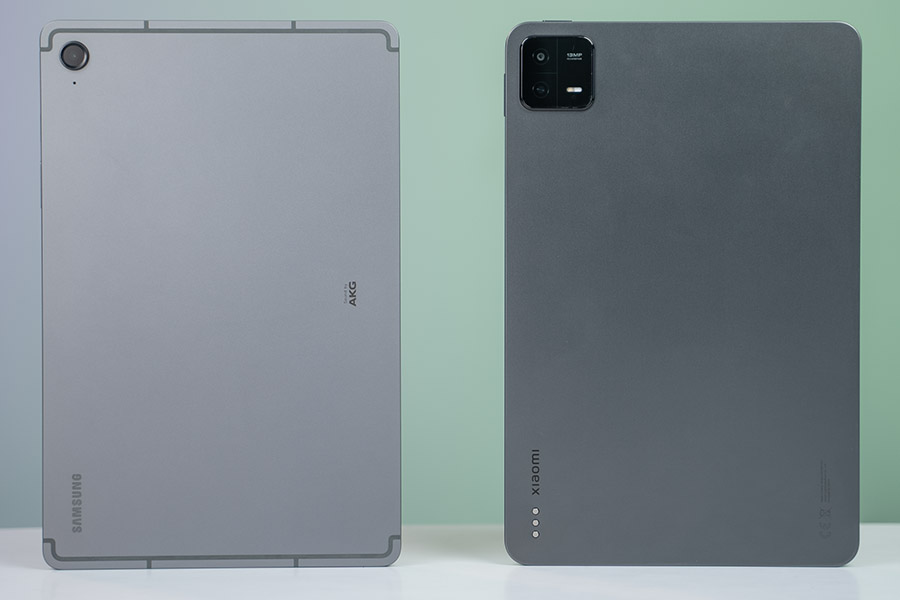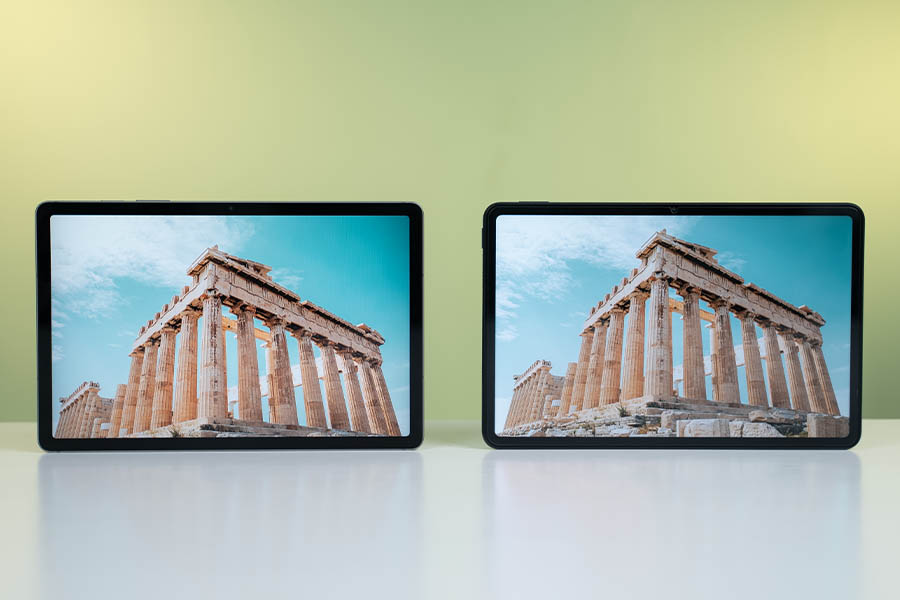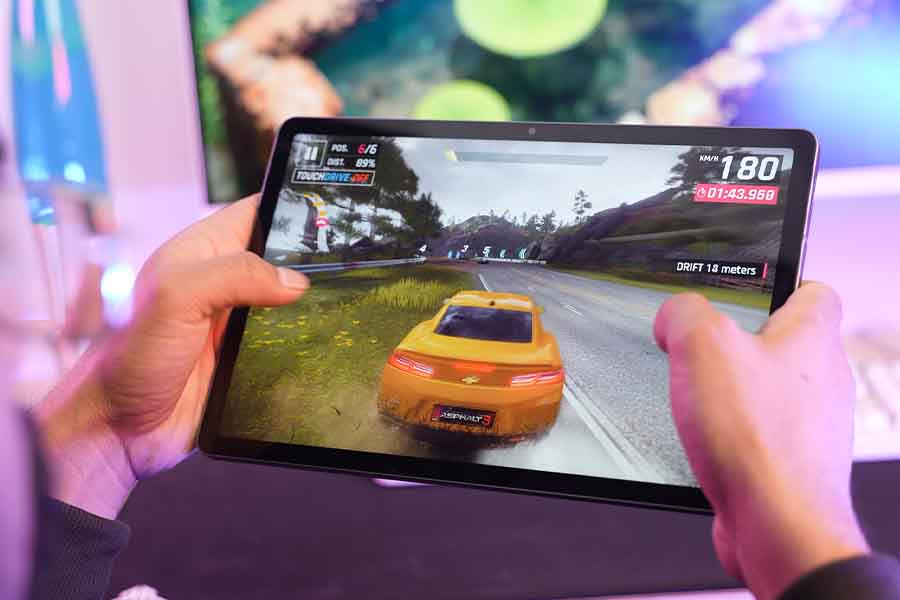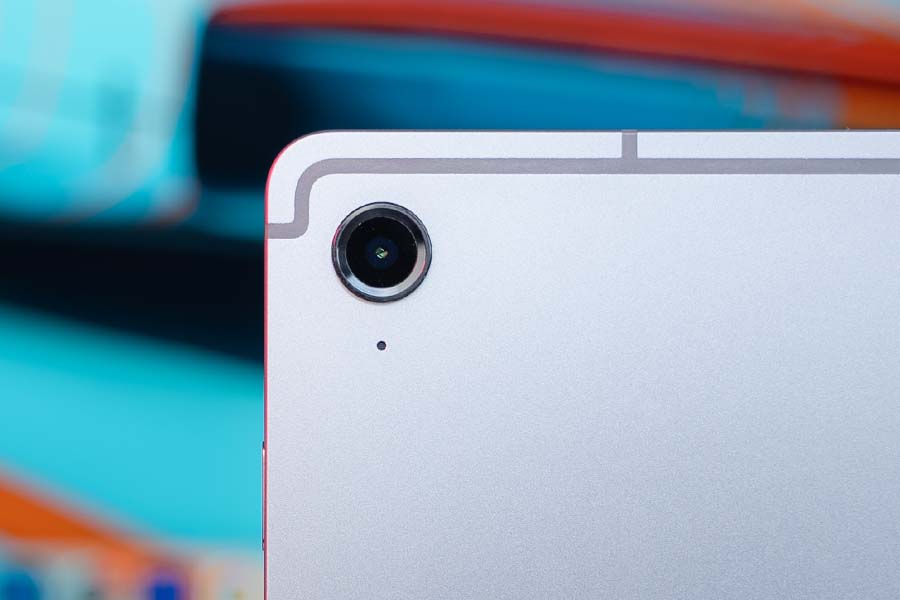Why Trust Gadgetbyte?
At Gadgetbyte, we invest substantial hours into rigorously testing each product or service we review, guaranteeing that you make informed purchases. Learn more about our testing process.
Review Overview
Design and Build
9/10
Display
8/10
Performance
6.5/10
Back Camera
7/10
Front Camera
7.5/10
Software and UI
8.5/10
Battery
8/10
Audio
7.5/10
Value for Money
6.5/10
The Galaxy Tab S9 FE is Samsung’s latest offering in the tablet space. And while it has its own set of strengths like a premium feeling build, included S-Pen, and 5G connectivity, Samsung could have paired it with a better chipset or an AMOLED screen to make it more compelling.
If you’re in the market for a midrange Android tablet, the Xiaomi Pad 6 is one of my top recommendations. It’s a testament to how far Xiaomi’s tablets have come in terms of hardware and software. However, Samsung’s new Galaxy Tab S9 FE comes with its own perks like an included S Pen, an IP68 rating, and more refined software.
So, should you consider spending some extra for the Tab S9 FE or does the Xiaomi Pad 6 for Rs. 40,000 just make more sense? This review of the Samsung Galaxy Tab S9 FE aims to answer just that.
Samsung Galaxy Tab S9 FE Specifications:
- Body: 254.3 x 165.8 x 6.5 mm, 524 gm, All-metal construction
- Display: 10.9-inches TFT LCD, 90Hz Refresh Rate, 16M colors
- Resolution: WUXGA+(2304 x 1440 pixels), 16:10 aspect ratio
- Chipset: Exynos 1380 (5nm Mobile Platform)
- CPU: Octa-core (4x Cortex-A78 at 2.4GHz and 4x Cortex-A55 at 2.0GHz)
- GPU: Mali-G68 MP5
- Memory: 6/8GB RAM, 128/256GB storage (expandable)
- Software & UI: Android 13 with Samsung's One UI 5.1 on top
- Rear Camera: Single (8MP sensor, 1080p/30fps videos)
- Front Camera: 12MP sensor (4k/30fps videos)
- Audio: Dual stereo speakers (Tuned by AKG), Dolby Atmos audio
- Security: Face unlock, Fingerprint reader
- Sensors: Accelerometer, Gyro, Geomagnetic, Hall, Light
- Connectivity: Single-SIM (Nano), WiFi 802.11 a/b/g/n/ac (Dual-band), Bluetooth 5.0, GPS / AGPS / Glonass / Galileo / Beidou, USB Type-C, 4G LTE, 5G (WiFi only variants also sold in some markets)
- Battery: 8,000mAh with 45W fast charging (No adapter inside the box)
- Color options: Grey, Mint, Silver, Lavender
- Price in Nepal: Rs. 80,999 (6/128GB | 5G)
- Read the full specifications of the Samsung Galaxy Tab S9 FE here.
Samsung Galaxy Tab S9 FE Review:
I’ve been using these two tablets for a couple of weeks to figure that out exactly. So here, I’ll be sharing all my experiences with the Galaxy Tab S9 FE and the Xiaomi Pad 6 to help you make an informed buying decision. Let’s begin.The Price and the Pen
Okay, even though Xiaomi has you buy a "Smart Pen" separately, its stylus combo (Pad + Stylus = ~NPR 50,000) is still more affordable than the Tab S9 FE (NPR 81,000). And the second-gen Xiaomi Smart Pen is pretty dang good if you really want a pen to go with your tablet.
But Samsung’s S Pen isn’t any less impressive either. It’s perfectly workable for taking notes, casual doodling, or even drawing sketches. I did notice a bit of input delay, although that’s so not a big deal. Whereas things like quick preview and being able to scribble on any text field instead of typing are awesome to have too.
Review Images
1/2
Attaches on the sides or back
Design and Build
- 254.3 x 165.8 x 6.5 mm, 524 gm
- Metallic construction, glass front
- Separate Keyboard Folio accessory
Design-wise, both Samsung and Xiaomi have gone with a premium-feeling metal build on these tablets with flat edges and a fairly slim profile. And this is pretty much as good as it gets for a midrange tablet in terms of the build quality. The Tab S9 FE is a tad heavier (524 grams) than the Xiaomi Pad 6 (490 grams) on paper but when holding them side by side, that was quite hard to tell since Samsung has essentially nailed the weight distribution on this thing.

The Tab S9 FE also impresses with its fingerprint sensor, IP68 dust and water resistance, and optional 5G connectivity for better peace of mind. I definitely would’ve liked to see a fingerprint reader and a cellular variant of the Pad 6, but I must say I don’t really miss not having full dust and water sealing here. And the IP53 rating on the Xiaomi Pad 6 is plenty enough to survive through minor water splashes and stuff.
Instead, it's USB 3.2 port that enables wicked-fast data transfer and the ability to connect to a 4K external display is a much more useful design choice in my opinion. And since the Tab S9 FE still only has a USB 2.0 connection, it doesn’t even support DeX on external devices for a desktop-like experience. This is especially disappointing when you realize that the older Galaxy Tab S7 FE actually supported wireless DeX mode.
Display
- 10.9-inches WUXGA+ TFT LCD screen
- 90Hz refresh rate, 16:10 aspect ratio
As for the display, both these tablets feature high-res LCD panels with a tall 16:10 aspect ratio. And when looking at their spec sheet, the Xiaomi Pad 6 has some pretty obvious advantages, right? Including a sharper pixel density and a richer 10-bit color depth that’s capable of producing over a billion colors.
[caption id="" align="alignnone" width="900"]
All that sounds great but I didn’t find Tab S9 FE to be falling behind in terms of sharpness or color reproduction in any way either. But yes, that 144Hz refresh rate on the Xiaomi Pad 6 makes a world of difference compared to Samsung’s 90Hz screen. Trust me.
For such a big screen, 90Hz simply doesn’t feel as fast or as responsive as you’d want. Its response time is also rather slow, which means you’ll often notice pixel trails — aka ghosting — when quickly swiping through the UI or something on the Tab S9 FE. Even after dialing down the system animation to exactly half, it still can’t keep up with the fluidity of the Xiaomi Pad 6’s 144Hz display in any meaningful way.
Media Machines
And the media consumption experience is kinda… all over the place on these tablets. The Xiaomi Pad 6 is HDR-certified on Netflix but it struggles with tone-mapping for true HDR playback, while the Tab S9 FE isn’t HDR-certified on Netflix at all. One weird issue I encountered on the Tab S9 FE is that — for whatever reason — it just can’t play 4K HDR videos on YouTube. It’s most likely YouTube’s bug though since the tablet played my local 4K HDR files without much hiccup.
On that note, the quad speakers on the Xiaomi Pad 6 are a clear winner over Samsung’s dual speaker setup in my books. It gets louder and sounds more detailed and fuller as well.
Performance
- Octa-core Exynos 1380 SoC (5nm)
- 6/8GB RAM, 128/256GB storage (expandable)
- Android 13 with Samsung’s One UI 5.1 on top
Alright, let’s talk performance now. And right away, I’m disappointed with Samsung here because the Galaxy Tab S9 FE uses the notorious Exynos 1380 chip that we saw on the Galaxy A54. It’s significantly more capable than Tab S7 FE’s Snapdragon 750G or Snapdragon 778G on paper but all that raw horsepower has essentially gone to waste since Samsung still hasn’t managed to get the most out of this chip even after all this time.
Whereas the Snapdragon 870 chip on the Xiaomi Pad 6 — despite its age — is arguably one of Qualcomm’s best, most well-optimized mobile processors so far. And this becomes clear as day when running benchmarks or in real-world usage itself.
Review Images
1/2
Antutu
I’m definitely not saying that the Tab S9 FE’s performance is absolutely trash or anything. After all, it can handle casual web scrolling, video streaming, and multi-window workflows just fine. But the occasional bits of stutter every now and then are pretty frustrating on such a relatively high-end machine. And maybe it’s because it's the base model with just 6 gigs of RAM, I also had some apps reload on me after some time.
Gaming
Even when it comes to gaming, the Xiaomi Pad 6 is the better-optimized of the two. Literally all the games I tried like Asphalt 9, Call of Duty, PUBG, and Genshin Impact play more smoothly on the Pad 6 — that too with better graphics, cooler temperature, and all.

Genshin Impact does push the tablet to its limit though as it got HOT (37˚C) with noticeable dips in frame rate at certain parts.
Review Images
1/7
Software
- One UI 5.1 based on Android 13
That brings me to the software side of things. This is something where Samsung has always had an upper hand, and the way it has repurposed One UI for a large-screen device over the years definitely has its advantages. Like how the control panel so intuitively pops up depending on where I open it from, or how having multiple apps open at a time is so much easier and elegant on the Tab S9 FE.
Review Images
1/2
Control Panel pops up on the left
But as I said in the very beginning, Xiaomi has seriously leveled up its software game in recent years. And after using both these tablets side by side, I feel like most people would be happy with the features and usability of MIUI for Pad just fine.
The Tab S9 FE’s taskbar — that I can access from anywhere — is extremely useful for multitasking, although Xiaomi has something similar in the form of a “persistent dock” on the Pad 6, it just ain't as good as Samsung's.
Moreover, you also don't get any sort of software commitment from Xiaomi here. On the other hand, Samsung promises 4 major OS upgrades and 5 years of security updates for the Tab S9 FE. So, you can expect new features and further optimizations on the Samsung tablet which is not the case with Xiaomi's Pad 6.Camera
- 8MP back, 12MP front, 4k 30 fps (front)
What’s more? Oh yeah, the cameras. The Tab S9 FE comes with an 8MP sensor at the back and a 12MP one on the front, whereas the Pad 6 has a 13MP + 8MP setup going for itself.

And taking the Tab S9 FE for a spin, I found it to live up to the “tablet camera” stereotype with not a lot of detail in the shot. It’s fine for scanning documents or taking a quick shot when you don’t have your smartphone near you, but that’s about it.
Review Images
1/11
Battery Life
- 8000 mAh battery
- 45W fast charging support
- No Charger in the box
As for battery life, things are kinda neck-and-neck between these two. The Xiaomi Pad 6 does have a larger battery unit but it’s also fueling a power-hungry 144Hz screen and everything so all in all, I was getting around 8 hours of screen time on average here. I am giving a slight advantage to the Pad 6 in terms of charging though since Xiaomi ships a compatible 33W charger inside the box itself. Whereas you’ll need to buy a 25W or a 45W power brick separately for the Tab S9 FE.
Samsung Galaxy Tab S9 FE Review: Conclusion
Okay, let’s wrap things up now. So, if you want a decent multimedia experience and something that can cruise through everyday usage and all, the Xiaomi Pad 6 is the best option out there for just Rs. 40,000. Even if you’re someone who’s gonna make the most out of a tablet by multitasking, gaming, or by pairing it with accessories like a stylus, this is clearly the way to go.
For Rs. 81,000, the Tab S9 FE doesnt posses the best value as it comes with a weak Exynos processor and a ordinary 90Hz screen. However, you can still opt for it, if you are in a Samsung ecosystem, and need 5G connectivity.
Samsung Galaxy Tab S9 FE Review: Pros & Cons
Pros:- Premium Build, IP68 Rating
- Stylus included in the box
- Optimised Software
- Decent battery backup
- Optional 5G connectivity
- Not the best value for money
- Unoptimized Exynos chip
- Just 90Hz display
- No Charger in the Box

To say something about myself, I have been writing tech and gadgets from 2021. Although coming from a non technical studies background, I'm someone who is always fascinated by the latest gadget and tech innovations, circling around. Besides writing, you'll find me listening music and aligning the stars through astrology and sometimes even, tarot cards! 😉🧿
Comments
No comments yet. Add a comment to start a discussion





















































